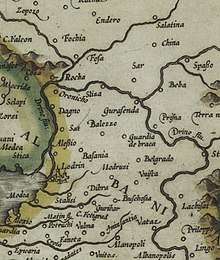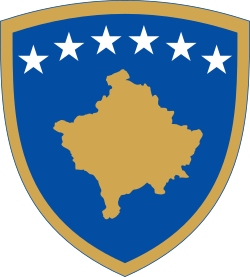Dragaš
Dragash or Sharr (Albanian: Dragashi or Sharri) or Dragaš (Serbian Cyrillic: Драгаш), is a town and municipality located in the Prizren District of Kosovo.[lower-alpha 1] According to the 2011 census, the town of Dragaš has 1,098 inhabitants, while the municipality has 34,827 inhabitants.[1] The Albanian name Sharri is a reference to the Šar Mountains (in Albanian Sharr). The Serbian name Dragaš comes from medieval Serbian lord Constantine Dragaš.[2]
Dragaš
| |
|---|---|
Town and municipality | |
 Emblem | |
 Location of the municipality of Dragaš within Kosovo | |
| Coordinates: 42°03′40″N 20°39′10″E | |
| Country | Kosovo[lower-alpha 1] |
| District | District of Prizren |
| Government | |
| • Mayor | Shaban Shabani |
| • Municipal | 430 km2 (170 sq mi) |
| Elevation | 1,050 m (3,440 ft) |
| Population (2011) | |
| • Urban | 1,098 |
| • Municipal | 34,827 |
| • Municipal density | 81/km2 (210/sq mi) |
| Time zone | UTC+1 (CET) |
| • Summer (DST) | UTC+2 (CEST) |
| Postal code | 22000 |
| Area code(s) | +381 |
| Car plates | 04 |
| Website | kk |
Geography
The territory of the Dragaš municipality lies in the northern latitude of 41 52' 30" to 42 09' 03" and longitude of 20 35' 39" to 20 48' 26". The whole territory is surrounded by the Šar Mountains, then Koritnik Mountain, mountain Gjalic and Cylen in the direction of Prizren. Only one part of the territory in Prizren direction is hilly with a relatively slight slope by which this territory is connected with Prizren basin and through Prizren with the world.
History

Dragaš was named after Serbian medieval noble family of the same name which served Dušan the Mighty (r. 1331-1355) and Uroš the Weak (r. 1355-1371).
From 1877 to 1913, Dragaş was part of Kosovo Vilayet in the Ottoman Empire.
From 1929 to 1941, Dragaš was part of the Vardar Banovina of the Kingdom of Yugoslavia.
From 1941 to 1999 Dragaš was part of the autonomous province of Kosovo within the republic of Serbia and part of the Yugoslav federation.
The Gora municipality and Opoja region (attached to Prizren municipality) remained separated during the Milošević period.[3][4] During the Kosovo war (1999), Albanians from Opoja fled to neighbouring Albania in cars, trucks and tractors along with others on foot that following the conflict returned home.[5] After the war, the Gorani-majority Gora municipality was merged with the Albanian inhabited Opoja region to form the municipality of Dragash by the United Nations Mission (UNMIK) and the new administrative unit has an Albanian majority.[3][6][5]
The town of Dragash is the regional and municipal centre for both the Gora and Opoja regions of Dragash municipality.[3] Following 1999, Dragash has a mixed population of Gorani, whom live in the lower neighbourhood and Albanians in the upper neighbourhood that constitute the majority of inhabitants.[3]
Apart from the multiethic town of Dragash, the Gorani of Kosovo continue to live in villages primarily inhabited by their community in Gora and relations with Albanians remain tense.[3] Albanians predominately live in the Opoja region.[5] Mixed marriage between both communities do not occur with the exception of a few Gorani families that have migrated to Prizren.[3]
Municipality
Aside from the town of Dragaš, the following settlements consist the municipality:
- Baçkë/Bačka
- Bellobrad/Belobrod
- Blaç/Bljač
- Breznë/Brezna
- Brod/Brod
- Brodosanë/Brodosavce
- Brrut/Brut
- Buçë/Buča
- Buzez/Buzec
- Dikancë/Dikance
- Glloboçicë/Globočica
- Kapër/Kapra
- Kërstec/Donji Krstac
- Kosavë/Kosovce
- Krushevë/Kruševo
- Kuk/Kukovce
- Kukjan/Kukuljane
- Kuklibeg/Kuklibeg
- Leshtan/Leštane
- Lubovishtë/Ljubovište
- Mlikë/Mlike
- Orçushë/Orčuša
- Plavë/Plava
- Pllajnik/Plajnik
- Radeshë/Radeša
- Rapçë/Gornja Rapča
- Rapçë/Donja Rapča
- Restelicë/Restelica
- Rrenc/Rence
- Shajnë/Šajinovac
- Vranishtë/Vranište
- Xërxë/Zrze
- Zaplluzhë/Zaplužje
- Zgatar/Zgatar
- Zlipotok/Zli Potok
- Zym/Zjum Opoljski
Demographics
| Year | Pop. | ±% p.a. |
|---|---|---|
| 1971 | 26,850 | — |
| 1981 | 35,054 | +2.70% |
| 1991 | 39,435 | +1.18% |
| 2011 | 34,827 | −0.62% |
According to the last official census done in 2011, the municipality of Dragaš has 34,827 inhabitants. Based on the population estimates from the Kosovo Agency of Statistics in 2016, the municipality has 34,349 inhabitants. The municipality's population mostly lives in rural areas (97%).
Ethnic groups
The municipality is split into the regions of Opolje and Gora. Most of the Gorani live in Gora, whilst most Albanians live in Opoja and are majority population of whole municipality.[3][5]
Due to geopolitical circumstances, some of the local Gorani people have over time self declared themselves as Albanians, Macedonians, Bosniaks, Muslim Bulgarians, Serbs, Turks and Muslims (nationality).[7] [8]
The ethnic composition of the municipality:
- 1971 – 13,867 (51.6%) Albanians; 11,076 (41.3%) Gorani and Bosniaks – total 26,850
- 1981 – 18,623 (53%) Albanians; 15,942 (45.5%) Gorani and Bosniaks – total 35,054
- 1991 – 22,785 (57.8%) Albanians; 16,129 (40.9%) Gorani and Bosniaks – total 39,435
OSCE estimates say the following:[1]
- January 1999 – 27,633 (61.3%) Albanians; 17,470 (38.7%) Gorani and Bosniaks – total 45,103
- March 2000 – 24,856 (78%) Albanians; 9,706 (28.1%) Gorani and Bosniaks – total 34,562
- January 2006 – 22,800 (55.9%) Albanians; 17,975 (44.1%) Gorani and Bosniaks – total 40,775
According to the census in 2011, a significant number of people (4,100) self identified as Bosniaks in the municipality.
Economy
The main employers in the area are the Municipality, UNMIK police, and private companies as “KUK Commerc”, “Meka” and former state-owned enterprises.[1]
All major local companies were formerly state-run and, as elsewhere in Kosovo, are currently under the responsibility of KTA. The original UNMIK strategy towards these public enterprises consisted of carrying out a process of ‘commercialisation’. This process was believed to be the best way to revive the enterprises, although no foreign investors decided to invest.[1]
Infrastructure
The municipality is mountainous and therefore has related infrastructural problems (e.g. problematic access to some villages during winter season). Its infrastructure was in a state of serious disrepair before the war, due to a combination of harsh winters and state neglect. Roads, in particular, (Zhur–Dragaš; Dragaš-Brod; Dragaš- Restelica) require urgent improvement for the social-economic development of the area. Bus connections between Dragaš town and the Opoja area continue to improve and the services to Gora are organized by the two OSCE-SIMF buses donated to the municipality. There is a free school bus service provided by the municipality along Gora routes. Taxi services exist but are largely unaffordable for the population. OSCE through SIMF/ ECSF funds supported also the rehabilitation of the Heath House.
Mobile coverage is also improving. Water supply is ensured in all villages.[1]
Symbol
The emblem of Dragaš includes an image of the Šarplaninac dog.[9]
The other symbol of Dragash is Šar cheese.
Notes and references
- Notes
- Kosovo is the subject of a territorial dispute between the Republic of Kosovo and the Republic of Serbia. The Republic of Kosovo unilaterally declared independence on 17 February 2008, but Serbia continues to claim it as part of its own sovereign territory. The two governments began to normalise relations in 2013, as part of the 2013 Brussels Agreement. Kosovo is currently recognized as an independent state by 97 out of the 193 United Nations member states. In total, 112 UN member states recognized Kosovo at some point, of which 15 later withdrew their recognition.
- References
- Gora, Opolje i Sredska. Geografski institut "Jovan Cvijić" SANU. 1997. ISBN 978-86-80029-04-7.
- Milisav V. Lutovac (1955). Gora i Opolje: antropogeografska proučavanja. Naučna knjiga.
- OSCE "municipal profile of Dragaš" (PDF)., June 2006. Retrieved on 21 February 2008.
- Cawley, Charles, Serbia, Medieval Lands database, Foundation for Medieval Genealogy,
- Schmidinger, Thomas (2013). Gora: Slawischsprachige Muslime zwischen Kosovo, Albanien, Mazedonien und Diaspora. Wiener Verlag. p. 65. ISBN 9783944690049.CS1 maint: ref=harv (link)
- Weller, Marc (1999). The crisis in Kosovo 1989-1999. Documents and Analysis Publishing. p. 117. ISBN 9781903033005.CS1 maint: ref=harv (link) "Consequently, the region extending north of Dragas city to Prizren, known as Opoje, which comprises 24,000 Albanians in 19 villages are grafted on to the Municipality of Prizren"
- Krasniqi, Elife (2016). "Social Change in Relation to Patriarchy after 1999 war in Opoja, Kosovo". In Roth, Klaus; Kartari, Asker (eds.). Culture of Crisis in Southeast Europe, Part I: Crises Related to Migration, Transformation, Politics, Religion, and Labour. LIT Verlag. p. 191. ISBN 9783643907639.CS1 maint: ref=harv (link)
- Bardhoshi 2016, p. 83.
- "Albania's Gora Minority Takes Bulgarian Route to EU: Balkan Insight". www.balkaninsight.com. 2016-04-18. Retrieved 15 September 2017.
- Bardhoshi, Nebi (2016). "Small Numbers, Big issues: The Border areas as Social Arena of Legal Systems". In Schüler, Sonja (ed.). Exchange, Dialogue, New Divisions?: Ethnic Groups and Political Cultures in Eastern Europe. LIT Verlag. p. 85. ISBN 9783643802095.CS1 maint: ref=harv (link)
- Municipal Assembly of Dragaš Archived July 12, 2006, at the Wayback Machine. – Retrieved on 20 November 2008.
External links
| Wikimedia Commons has media related to Dragaš. |
- "Municipality of Dragash". Republic of Kosovo.
